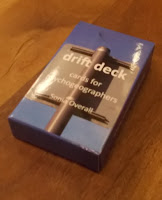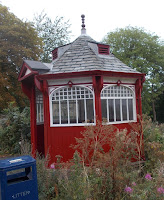This post is tiresomely long: you may care to jump ahead to a point of interest [sic].
Images will be clearer if clicked upon.
Introduction
The Welsh in Huddersfield
Registration
What is Psychogeography?
Boundary no boundary
New slices through old places
The world's shortest dérive
The Head of Steam
Huddersfield
A bus dérive to Marsden
The Red and Green Club
Slaithwaite
Coffee race
Introduction
The 4th World Congress of Psychogeography convened in Huddersfield in 2016; at the end of the programme it was not formally closed so when it reconvened in 2017, that was the 2nd 4th World Congress of Psychogeography. This year I attended the 3rd 4th World Congress of Psychogeography on September 7th and 8th, and may well attend the 4th 4th ... next year.
The Welsh in Huddersfield
Approaching the Congress via a cashpoint, I was surprised to find the Santander branch had two cashpoints that were both conversing in Welsh. In my own land this is common, usually with an option to deal in English. These two did not offer that option so I felt very knowledgeable when extracting money successfully. I had a chat with the lady in the branch on the topic, thanking her for making me welcome. I don't think she believed me.
Sadly and stupidly, I did not photograph this.
Registration
The Congress was free to attend. On arrival there was a flipchart listing some of the forthcoming options - this is instructive, and rather set the tone for the Congress.
(although it did turn out to be incomplete).
Day one was a mixture of formal sessions and outings: day two was all outings.
What is Psychogeography?
This was a jolly useful opening session as I turned up without any sort of coherent answer, and most other people knew what they were talking about. I did contribute to the discussion that, while I wasn't sure what Psychogeography was, I knew it when I saw it. People nodded at this.
I'm still unsure.
Boundary no boundary
The standout formal session for me was Tony Wade's circumnavigation of Wakefield in which he executed 20 3-mile stretches of the Ordnance Survey map boundary (as best he could), painting a triptych on each stretch and speaking with locals.
I especially liked his attempt to re-create one of the map dashes on the ground with lino, having first asked OS (unsuccessfully) how big it ought to be.
I won't insult him by including my photos of this - see instead his web site.
New slices through old places
My talk was received politely, although several people came up afterwards and said how much they had enjoyed it. I think I was a little frivolous for the more serious minded folk. (This was certainly true of my lecture on Leibniz, given in German on a quite different occasion).
If you're mad keen, read it here.
The world's shortest dérive
The outings began in the early evening.
David Upton led this, having pioneered the idea in Waterloo Station during rush hour - the idea was to negotiate a very short distance in a very long time.
He had planned to use Huddersfield rail station, but the geography of barriers, and the lack of variety of passenger behaviour, made him move it to the bus station:
This was jolly successful - I travelled about 25 yards in about 40 minutes and saw and heard rather more than I would normally. One feels very conspicuous and self conscious: if the surveillance system had been furnished with some AI, we would have been identified immediately as deeply suspicious.
I liked the way that the bus station was like a small version of the legendary Preston Bus Station (q.v.).
The Head of Steam
A very congenial evening social was held in the Head of Steam by the rail station.
Too much was said and drunk to remember or record, but we played Taylor Butler-Eldridge's excellent game
(note, inter alia, the dice). I was also given a copy of Sonia Overall's limited edition Psychogeography cards.
Thank you, Sonia!
Huddersfield
It was not possible to miss several highlights of Huddersfield: the
photographic record captures several, but highlights must be:
- Caged chess pieces
- Burtons 1 and
2. The second is a Macdonalds!
- Merrie England
- A to/from
milestone - no vagueness here!
- A listed bus shelter
- ... and several coal holes
A bus dérive to Marsden
Day 2 dawned rainy - good-oh, this is the day for outings.
We were "working our way up the valley" in several parties; by some sort of accident I joined John Rooney's bus dérive to Marsden, which involved catching a bus (which seems to take some of the uncertainty of the travel away). We were issued with notebooks in which to record anything that took our fancy - John collected these from us (for his PhD work) at the end so I cannot reproduce my many insightful observations and drawings, which captured well the weather, which made the bus windows opaque. We did notice that Manchester Road had house numbers in excess of 1000, which is unusual in the UK. Perhaps Manchester Road is long?
I shouldn't be flippant - this was provoking and enjoyable as a way of travel.
The Red and Green Club
Leaving John to return to Huddersfield, we disembarked at Milnsbridge to meet others at the fabled [sic] Red
and Green Club. It had once been the Socialist Club, and in a political comment, evolved into a Social Club. The environmentalists then swooped (?) and it is now red and green.
We actually dérived to the Club via Downtown Milnsbridge, where I had a mildly psychogeographic encounter with a postal worker who wanted to know if I was a tourist.
He didn't know of my fascination with all things postal.
The Club had some super socialist memorabilia with it.
Dave Smith gave a most entertaining talk on
Victor Grayson, something of a local lad. We were enjoined to go out and seek traces of him that postdated his mysterious disappearance ... I am afraid I failed in this task.
Slaithwaite
And thence to Slaithwaite for the remainder of the programme, although many stayed later to soldier up to Marsden for the end of the day. This involved a queue of psychogeographers - probably the wrong collective noun:
The rain by now was enthusiastic, so soggy psychogeographers holed up in the Civic Centre to drink tea and coffee, and eat
splendid locally provided cakes.
I opted for the Sonic Walk led by Victoria Karlsson; we visited 3 venues and listened to things audible and inaudible: the venues were
a colossal disused mill, a super viaduct (many arches), and a secret graveyard just nigh the railway station:
Time had passed and I had to make excuses to get to Halifax, so missed events after 4pm. Slaithwaite and Milnsbridge also had many coal holes, and the former had a splendid pharmacy where all the pills were blue!
Coffee race
The next morning, we had a race between the two identical coffee machines in Bill's kitchen.
Other pictures exist.
I'm looking forward to the 4th 4th World Congress.




















